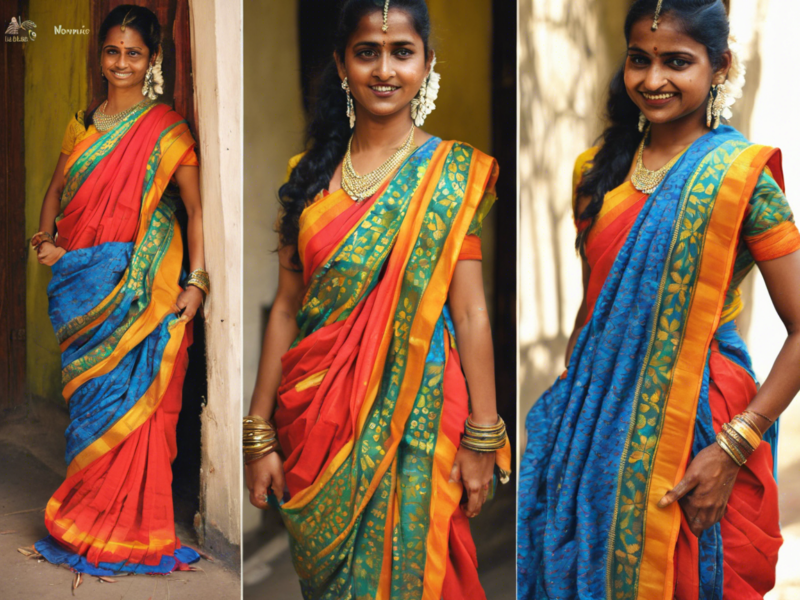Introduction
The Nauvari saree is a traditional Maharashtrian garment that holds immense cultural significance. Its name is derived from the Marathi word ‘nau,’ meaning nine, symbolizing the nine yards of fabric used to drape this exquisite saree. The Nauvari saree is not just a piece of clothing; it is a symbol of Maharashtrian culture, tradition, and pride. In this article, we will delve into the history, significance, draping styles, and modern-day appeal of the Nauvari saree.
History of Nauvari Saree
The origins of the Nauvari saree can be traced back to the Maratha Empire, where it was commonly worn by the women of the royal courts. Over time, the Nauvari saree became a symbol of Maharashtrian identity and pride, with women from all walks of life embracing this traditional attire. The nine yards of fabric are said to symbolize strength, versatility, and grace, qualities that are deeply ingrained in Maharashtrian culture.
Significance of Nauvari Saree
The Nauvari saree holds immense cultural and social significance in Maharashtrian society. It is often worn during festivals, weddings, religious ceremonies, and other important occasions. The draping style of the Nauvari saree is also symbolic, with the pallu (the loose end of the saree) draped from the back to the front, signifying dignity and grace.
Draping Styles of Nauvari Saree
One of the most distinctive features of the Nauvari saree is its unique draping style. There are various ways to drape the Nauvari saree, with each style reflecting the wearer’s personal taste and occasion. The most common draping styles include the front pallu drape, Kolhapuri style drape, and Madhuri dixit style drape. Each style adds a touch of elegance and sophistication to the overall attire.
Modern-Day Appeal of Nauvari Saree
In recent years, the Nauvari saree has experienced a resurgence in popularity, not just in Maharashtra but across India and even globally. Fashion designers have reimagined the traditional Nauvari saree, incorporating modern silhouettes, fabrics, and embellishments to appeal to a wider audience. Celebrities and influencers have also embraced the Nauvari saree, showcasing its timeless elegance and cultural significance on various platforms.
Tips for Wearing Nauvari Saree
- Choose a fabric that suits the occasion and season, such as cotton for casual events and silk for formal occasions.
- Pay attention to the drape of the saree, ensuring that it is neat and well-pleated.
- Accessorize with traditional Maharashtrian jewelry like nath (nose ring), kolhapuri sandals, and bangles to complete the look.
- Experiment with color combinations and embellishments to add a modern twist to the traditional attire.
- Practice draping the saree beforehand to ensure you are comfortable and confident in carrying off the Nauvari saree with grace.
Frequently Asked Questions (FAQs)
1. What is the significance of the nine yards in the Nauvari saree?
The nine yards of fabric in the Nauvari saree symbolize strength, versatility, and grace, reflecting the essence of Maharashtrian culture.
2. Can anyone wear a Nauvari saree, or is it reserved for specific occasions?
While the Nauvari saree is traditionally worn during festivals, weddings, and religious ceremonies, anyone can wear it to embrace Maharashtrian culture and tradition.
3. How do I drape a Nauvari saree if I am a beginner?
There are various tutorials available online that provide step-by-step instructions on draping the Nauvari saree. It might take some practice, but with patience, you can master the art of draping.
4. Is it necessary to wear traditional Maharashtrian jewelry with a Nauvari saree?
While traditional jewelry complements the Nauvari saree beautifully, you can experiment with contemporary jewelry styles to create a fusion look that suits your personal style.
5. Can the Nauvari saree be customized to suit individual preferences?
Yes, many designers offer customized Nauvari sarees with different fabrics, colors, and embellishments to cater to the unique preferences of the wearer.
6. How can I style my hair when wearing a Nauvari saree?
You can opt for traditional Maharashtrian hairstyles like bun or braid, adorned with flowers or hair accessories to complement the overall look of the Nauvari saree.
7. Are there any specific footwear options that go well with the Nauvari saree?
Traditional Maharashtrian footwear like Kolhapuri sandals or wedges are popular choices to pair with the Nauvari saree, adding an authentic touch to the ensemble.
8. Can the Nauvari saree be worn for casual outings, or is it more suitable for formal events?
You can style the Nauvari saree for both casual and formal occasions, depending on the fabric, color, and embellishments. Opt for lightweight cotton sarees for casual outings and silk or embellished sarees for formal events.
9. How do I care for my Nauvari saree to ensure it stays in good condition?
It is essential to follow the care instructions provided with the saree, including dry cleaning or gentle hand washing, storing it in a cool, dry place, and avoiding direct sunlight to maintain the fabric’s quality and color.
10. Are there regional variations in the draping styles of the Nauvari saree?
Yes, different regions in Maharashtra may have variations in the draping styles of the Nauvari saree, reflecting unique cultural influences and traditions.
In conclusion, the Nauvari saree is not just a garment; it is a symbol of Maharashtrian heritage, tradition, and elegance. Embracing the Nauvari saree is not just about wearing a piece of clothing; it is about celebrating and honoring the rich cultural tapestry of Maharashtra. Whether worn during festivals, weddings, or special occasions, the Nauvari saree exudes grace, dignity, and timeless beauty, making it a treasured attire for women across generations.




